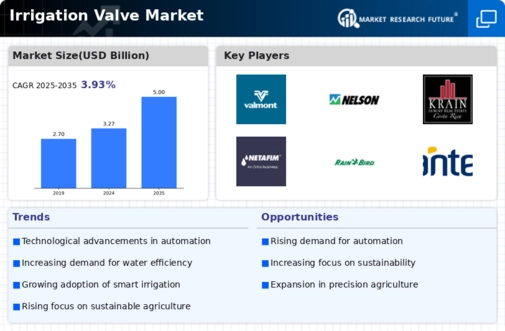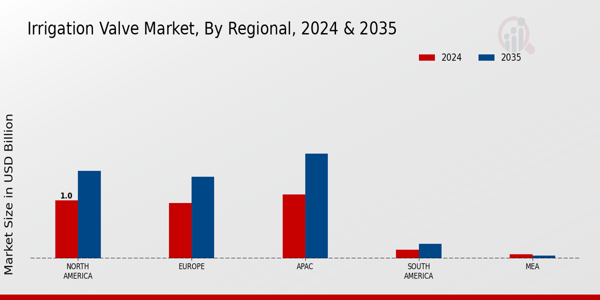Climate Change Adaptation
The impacts of climate change are prompting a reevaluation of water management strategies, thereby affecting the Irrigation Valve Market. As weather patterns become increasingly unpredictable, farmers are compelled to adopt more resilient irrigation systems that can withstand varying climatic conditions. This necessity for adaptability is driving the demand for advanced irrigation valves that offer flexibility and reliability. Market analysis suggests that regions experiencing extreme weather events are likely to see a 15 percent increase in the adoption of innovative irrigation solutions. Consequently, the Irrigation Valve Market is poised for growth as stakeholders seek to mitigate the risks associated with climate variability.
Environmental Regulations
The implementation of stringent environmental regulations is influencing the Irrigation Valve Market, as governments worldwide seek to promote sustainable water management practices. These regulations often mandate the use of efficient irrigation systems that minimize water wastage, thereby driving demand for high-quality irrigation valves. For instance, policies aimed at reducing agricultural runoff and conserving water resources are becoming more prevalent. Market data indicates that regions with strict water management laws are witnessing a surge in the adoption of advanced irrigation technologies, including precision irrigation systems. As compliance with these regulations becomes essential, the Irrigation Valve Market is expected to expand as stakeholders invest in compliant solutions.
Technological Innovations
Technological advancements are reshaping the Irrigation Valve Market, introducing smart irrigation systems that optimize water usage. Innovations such as automated valves and remote monitoring systems allow for precise control over irrigation schedules, reducing water waste. The integration of Internet of Things (IoT) technology into irrigation systems is particularly noteworthy, as it enables real-time data collection and analysis. This shift towards smart irrigation solutions is reflected in market data, which suggests that the adoption of such technologies could lead to a 20 percent increase in irrigation efficiency. As farmers increasingly recognize the benefits of these innovations, the Irrigation Valve Market is likely to experience substantial growth.
Rising Agricultural Demand
The increasing global population drives a heightened demand for agricultural products, which in turn propels the Irrigation Valve Market. As food production needs escalate, farmers are compelled to adopt efficient irrigation systems to maximize yield. This trend is underscored by data indicating that agricultural water use accounts for approximately 70 percent of total freshwater withdrawals. Consequently, the need for reliable irrigation valves becomes paramount, as they play a critical role in managing water resources effectively. The Irrigation Valve Market is thus positioned to benefit from this rising agricultural demand, as stakeholders seek innovative solutions to enhance productivity while conserving water.
Investment in Agricultural Infrastructure
Investment in agricultural infrastructure is a key driver for the Irrigation Valve Market, as governments and private entities allocate resources to enhance irrigation systems. This investment is often aimed at improving water delivery efficiency and ensuring food security. Recent data indicates that countries prioritizing agricultural development are witnessing a significant increase in funding for irrigation projects, which includes the installation of modern irrigation valves. As infrastructure improvements are implemented, the demand for reliable and efficient irrigation valves is expected to rise. This trend suggests a robust growth trajectory for the Irrigation Valve Market, as stakeholders capitalize on the opportunities presented by enhanced agricultural infrastructure.


















Leave a Comment